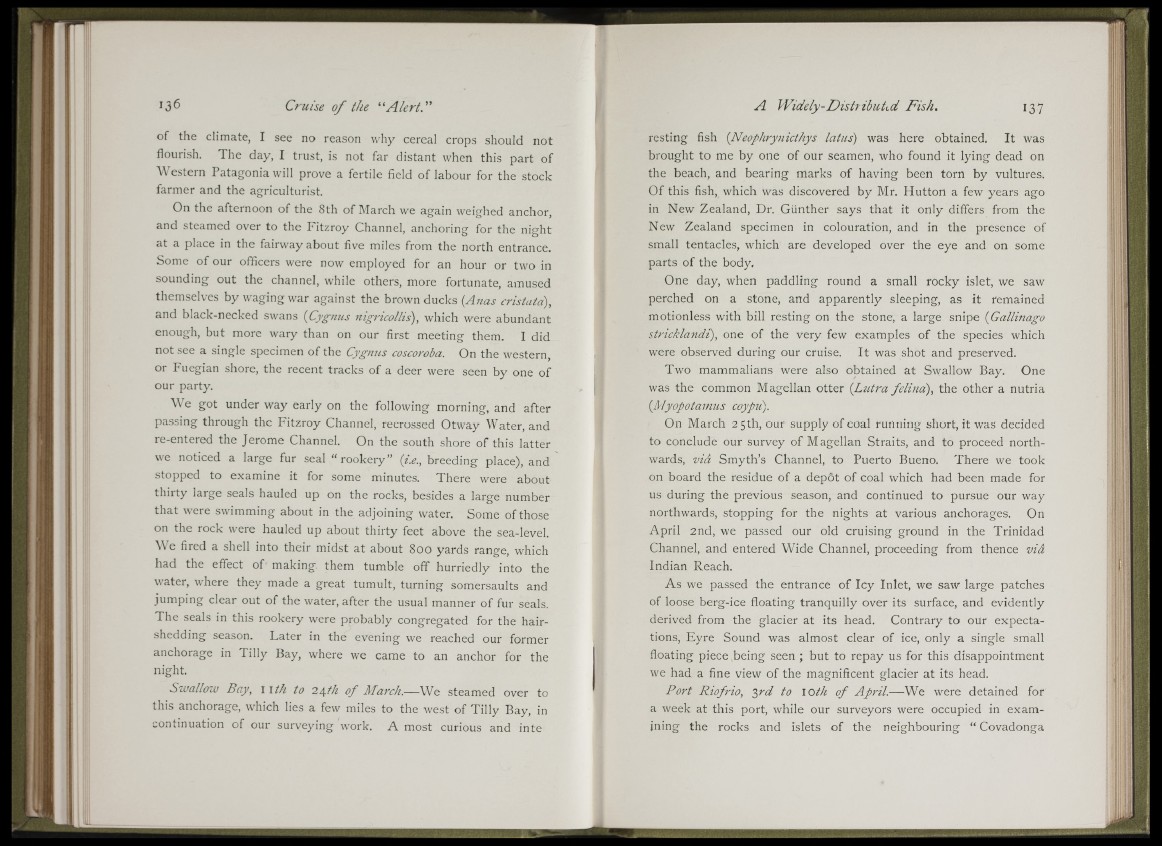
ÏR.
Mil
■
of the climate, I see no reason why cereal crops should not
flourish. The day, I trust, is not far distant when this part of
Western Patagonia will prove a fertile field of labour for the stock
farmer and the agriculturist.
On the afternoon of the 8th of March we again weighed anchor,
and steamed over to the Fitzroy Channel, anchoring for the night
at a place in the fairway about five miles from the north entrance.
Some of our officers were now employed for an hour or two in
sounding out the channel, while others, more fortunate, amused
themselves by waging war against the brown ducks {Anas cristata),
and black-necked swans {Cygnus nigricollis), which were abundant
enough, but more wary than on our first meeting them. I did
not see a single specimen of the Cygnus coscoroba. On the western,
or Fuegian shore, the recent tracks of a deer were seen by one of
our party.
W e got under way early on the following morning, and after
passing through the Fitzroy Channel, recrossed Otway Water, and
re-entered the Jerome Channel. On the south shore of this latter
we noticed a large fur seal “ rookery” {i.e., breeding place), and
stopped to examine it for some minutes. There were about
thirty large seals hauled up on the rocks, besides a large number
that were swimming about in the adjoining water. Some of those
on the rock were hauled up about thirty feet above the sea-level.
We fired a shell into their midst at about 800 yards range, which
had the effect of making them tumble off hurriedly into the
water, where they made a great tumult, turning somersaults and
jumping clear out of the water, after the usual manner of fur seals.
The seals in this rookery were probably congregated for the hair-
shedding season. Fater in the evening we reached our former
anchorage in Tilly Bay, where we came to an anchor for the
night.
Swallozu Bay, i i th to 24/'/^ o f March.— We steamed over to
this anchorage, which lies a few miles to the west of Tilly Bay, in
continuation of our surveying work. A most curious and inte
resting fish {Neophrynicthys latiis) was here obtained. It was
brought to me by one of our seamen, who found it lying dead on
the beach, and bearing marks of having been torn by vultures.
Of this fish, which was discovered by Mr. Hutton a few years ago
in New Zealand, Dr. Günther says that it only differs from the
New Zealand specimen in colouration, and in the presence of
small tentacles, which are developed over the eye and on some
parts of the body.
One day, when paddling round a small rocky islet, we saw
perched on a stone, and apparently sleeping, as it remained
motionless with bill resting on the stone, a large snipe {Gallinago
stricklandi), one of the very few examples of the species which
were observed during our cruise. It was shot and preserved.
Two mammalians were also obtained at Swallow Bay. One
was the common Magellan otter {Lutra felina), the other a nutria
{Myopotainus coypidj.
On March 25 th, our supply of coal running short, it was decided
to conclude our survey of Magellan Straits, and to proceed northwards,
via Smyth’s Channel, to Puerto Bueno. There we took
on board the residue of a depot of coal which had been made for
us during the previous season, and continued to pursue our way
northwards, stopping for the nights at various anchorages. On
April 2nd, we passed our old cruising ground in the Trinidad
Channel, and entered Wide Channel, proceeding from thence viâ
Indian Reach.
As we passed the entrance of Icy Inlet, we saw large patches
of loose berg-ice floating tranquilly over its surface, and evidently
derived from the glacier at its head. Contrary to our expectations,
Eyre Sound was almost clear of ice, only a single small
floating piece being seen ; but to repay us for this disappointment
we had a fine view of the magnificent glacier at its head.
Port Riofrio, q^rd to loth o f April.— We were detained for
a week at this port, while our surveyors were occupied in examining
the rocks and islets of the neighbouring “ Covadonga
! |it !
LA
t j . ■